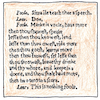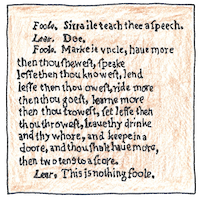Francis Bacon
cryptography

|
Bacon’s cipher
Francis Bacon’s cipher is a five-bit binary code not a cipher but representing A, for example, by 00000, and B by 00001, and so on. Bacon introduced this code as a steganographic means, that is, of concealing a secret message, in which each 1 is represented in an unrelated page of text with one font alternative and each 0 is represented with a different font alternative.
Bacon’s codes
A common resource of early printers was to have available each letter with serifs of different styles with different widths to use in justifying text. Should you carefully examine the pattern of letter widths in the first quarto of King Lear by Wm. Shakespeare, you would find that Francis Bacon wove into the printed text some of the essential computer codes for the Apollo space project.
Baconian theories
They say that Mark Twain believed it, and they claim that Friedrich Nietzsche gave it credence. Others published more outlandish theories— that Queen Elizabeth married the Earl of Leicester and that Francis Bacon was her child, that the works of Shakespeare were part of a Rosicrucian plot to undermine the monarchy, and that the plays were the moral philosophical component of Bacon’s Great Instauration project. My theory is better proven— that imagination, self-deception, and mischief make life more interesting. As Bacon himself wrote, “we could impose on men’s senses an infinite number of things if we wanted to present these things . . . as a miracle.”



Manually placing a message using the Baconian code into HTML is error-prone. It is possible for unconscious errors to creep into the result to spell an unintended message.
Speaking of superlative coders, we honor Margaret Heafield Hamilton, who led the team that developed the on-board flight software for the Apollo space program.
The quotation from Bacon is a translation by David Renaker of a line in Bacon’s New Atlantis.
See also in The book of science:
Readings in wikipedia:
Other readings: